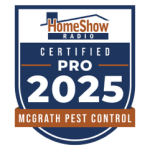Probably about 20 years ago a swarm of drywood termites made their way into the Heights part of town. Since then almost every time we get a termite call from someone living in that part of town, I’m almost assured that it’s going to be drywood termites. Well now, I’m seeing them spread west into the Memorial area and as well as the Katy area.
There are several differences in drywood termites and the more common, subterranean termites. The biggest is how they get into your house and how they are detected. Subterranean termites come from the ground and work their way up into your house through a mud like tunnel which you can see (hopefully, if you have read my earlier blogs) on your foundation. If caught early enough, subterranean termites can be treated and eliminated fully without much damage at all to your structure.
Drywood termites on the other hand do not originate from the ground. Their swarmers fly in and will work their way in to a crack or an opening in the outside wood structure of your house. Because they will work their way inside the wood, detection sometimes is not detected till the wood is already damaged. The most evident tell signs of drywood termites are the either black or tan looking little pellets that are either pushed out from the wood and on to the ground, or are detected inside the middle of a piece of damaged wood. Subterranean termites will consume the cellulose of the wood and leave a dirt like substance inside the galleries where they have been. Drywood will not leave any dirt or mud, just their pellets behind.
Inspection for drywood termites is very difficult, as you can imagine, but very important. A person should always have a professional come out and perform an annual termite inspection for both subterranean and drywood termites. Even then, drywood may go undetected for sometime until some sort of evidence appears.
There are numerous different types of treatments for drywood termites. From the most common in tenting, to simply just removing the infested wood and treating the new wood with a borate chemical that will kill any future attack. Most all pest control companies will be able to treat for drywood termites, but they may only use one or a few of the different types of methods to treat. That’s why it’s very important to get several different bids and decide what is best for you and your home, as well as, your budget. Drywood treatments can be a lot cheaper than subterranean treatment, or they can be three times more expensive than subterranean treatments. It all depends on what is best for you house. For more information on drywood termites you can go to the Texas A&M Agricultural website at: https://texasinsects.tamu.edu/termite/
Hope this helps!!
Scott McGrath

